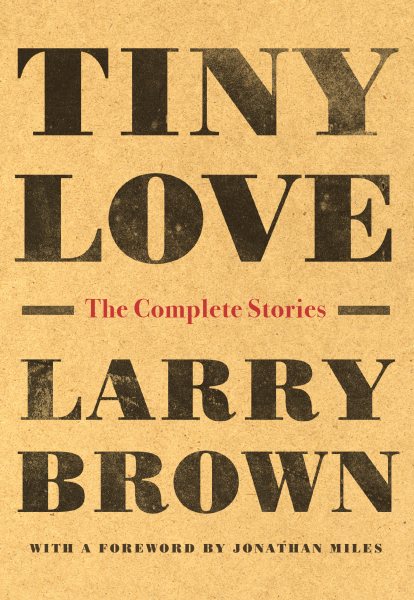Interview by Jana Hoops. Special to the Clarion-Ledger Sunday print edition (December 8)
 Fans of the late Oxford author Larry Brown need wait no longer to own a collection of his career short works in one volume, with the release of Algonquin’s Tiny Love: The Complete Stories of Larry Brown.
Fans of the late Oxford author Larry Brown need wait no longer to own a collection of his career short works in one volume, with the release of Algonquin’s Tiny Love: The Complete Stories of Larry Brown.
It was fitting that writer Jonathan Miles, (author of the novels Anatomy of a Miracle, Want Not, and Dear American Airlines, and who considered Brown to be both close friend and mentor since they met in Oxford in the early ‘90s) would be the one to contribute the foreword to the book.
“Larry published six novels, a memoir, a book of essays, and all the stories (in this new book), carving his name, indelibly, onto the thick tree trunk of American literature,” Miles states in the foreword. “He strained and he faltered, yes, but he never lost his faith.”

Larry Brown
Without any training in writing or previous publication of a single piece, Brown literally taught himself to write–and he persevered through seven years of rejections until the publication of his first collection of short stories, Facing the Music, in 1988. After his first novel, Dirty Work, was published, he would quit his job as a firefighter in Oxford to devote his efforts full-time to writing.
Among other recognitions, Brown would go on to win the Mississippi Institute of Arts and Letters Award for Fiction, the Mississippi Governor’s Award for Excellence in the Arts, and the Southern Book Award for Fiction–twice.
He died of an apparent heart attack at his home near Oxford in 2004.
Miles, a former columnist for the New York Times, served as a contributing editor to several national magazines, and his journalistic work appeared in the annual Best American Sports Writing and Best American Crime writing anthologies. A former longtime resident of Oxford, he now lives in rural New Jersey.
Miles shares his thoughts and memories about his friendship with Brown below.
How did the idea come about to publish all of Larry Brown’s work in one volume, and how were you chosen to write the foreword to this book?
The idea had been bouncing around, among Larry’s family and friends, for the last decade or more. The links between his two story collections – Facing the Music in 1988 and Big Bad Love in 1990–are so strong that combining them felt like a natural and graceful merger. The greater desire, however, was to finally corral all the stray stories that Larry published in magazines and anthologies, so as to gather the entirety of his short fiction into one definitive volume. Those includes his wild masterpiece, “A Roadside Resurrection,” which appeared in the Paris Review, as well as “Tiny Love,” the prickly, lovelorn title story, which Larry published in a charity anthology, as well as the early stories he published in biker and horror magazines. I’d been shepherding the idea along, over the years, and was honored when Algonquin, Larry’s longtime publisher, asked me to write the foreword.
Tell me about your friendship with Brown. How did you meet him, and what did you learn from him as a writer?

Jonathan Miles
I met Larry in 1992, a very memorable meeting that I wrote about in the foreword. It involves dancing on a table! Despite a 21-year age difference, we were instant pals. The Brown family adopted me, in just about every way, and neither Larry’s passing nor my move up north ever changed that–when I’m with them, I’m home.
As for writing, I’ve often said that my writing classroom was Larry’s pickup, and my classes were the hours Larry and I spent riding Lafayette County backroads. He often traced the origins of stories and scenes on those drives, pointing out the location of some real-life event and then explaining how he’d worked it into fiction, how he’d transformed it into art. Sharing the recipe with me, in a sense.
But the greatest lesson Larry gave me, and gave every artist, was the example of his persistence. Despite years of rejection, he never stopped writing. The only failure in art, he taught me, is not making art. You must always keep working.
Please describe Brown’s work in your own words. What do you admire about his work, and what drew you to it?
Larry Brown wrote about human frailties, about people in dire straits–emotional, romantic, financial, existential. The setting was almost always the rougher corners of north Mississippi, but the frailties were universal. Good people doing bad things, bad people doing good things. With limitless compassion, Larry sought to reconcile such human mysteries. From the first page he liked to load his characters with trouble–he called this “sandbagging”–and then chronicle their struggles to cast off this load, like the Old Testament’s God lobbing ordeals at Job. Yet by gauging what they could endure Larry showed what all of us can endure. There was a lot of darkness in Larry’s work but tremendous light, too.
Why was it important to finally publish all of Brown’s short work into one volume?
The hope is that this big new volume will draw a new generation to Larry Brown’s work and will reboot appreciation for one of the most singular voices in American literature. The people Larry wrote about don’t often appear in literary fiction, or, when they do, are rarely afforded the breadth of humanity that Larry gave them, the full bandwidth of their existence.
A young novelist from Alabama recently wrote me to say that he’d never met folks like himself and his family in books until reading his first Larry Brown book. Tim McGraw, a huge Larry fan, once told me that, unlike with most books he reads, he “recognized” the people in Larry’s work.
I hope this volume kindles more moments like that. I hope it leads more readers into Larry Brown’s north Mississippi, down those windy backroads. And I hope it helps to further cement his legacy as one of this state’s–and for that matter this nation’s–greatest writers.
What are some of your favorites among Larry’s work, and why?
In putting this collection together, I was struck, anew, by his story “Samaritans,” which appeared in Facing the Music. The setup for the story sounds like a joke setup: a little kid walks into a bar. But the story veers into dark, unsettling directions, and ultimately just claws at your heart. I’ve probably read it dozens of times but each time I do it feels slightly different–tonally, morally, the works. Certain paintings are like that; there’s always something new to see. Likewise, certain songs. That’s a hallmark of great art: it feels inexhaustibly alive.
Copies of Tiny Love: The Complete Stories of Larry Brown and Lemuria’s specially designed Larry Brown t-shirts (designed by Barry Gifford) are available in our online store and at our location in Banner Hall.


Comments are closed.